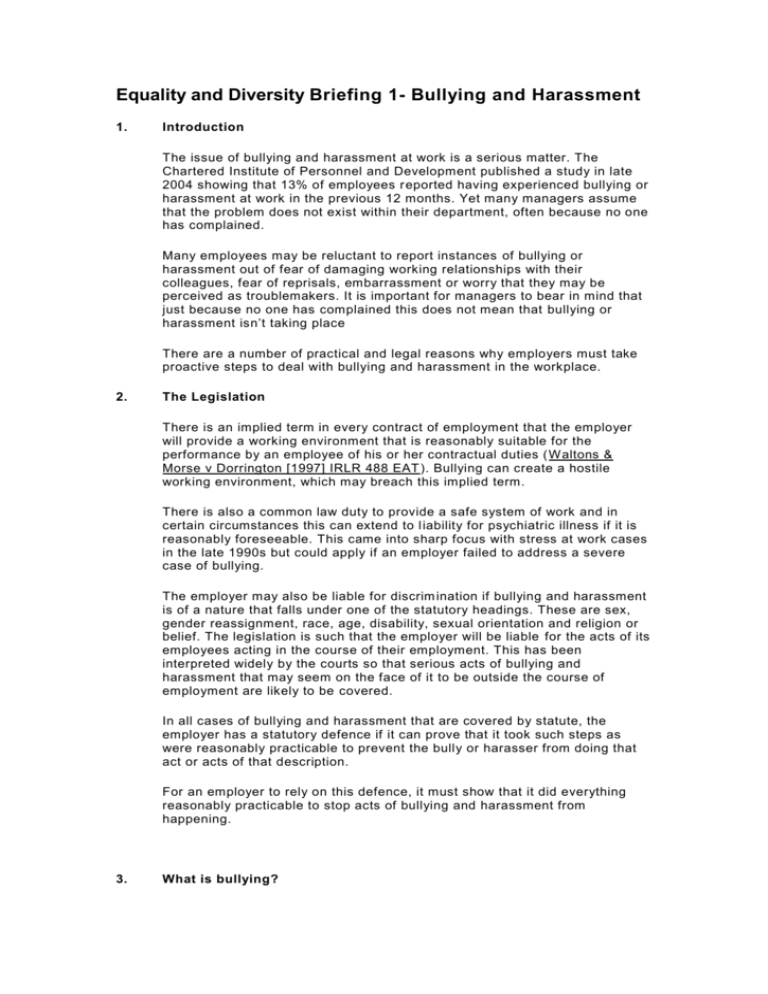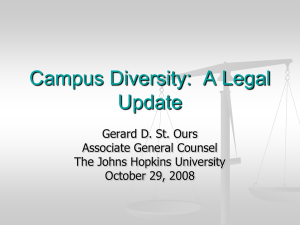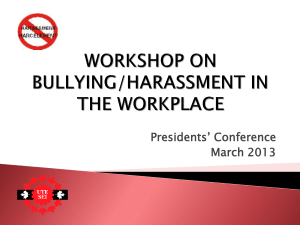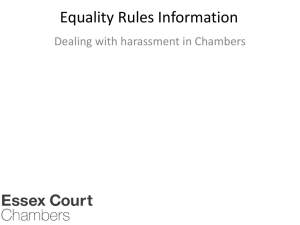
Equality and Diversity Briefing 1- Bullying and Harassment
1.
Introduction
The issue of bullying and harassment at work is a serious matter. The
Chartered Institute of Personnel and Development published a study in late
2004 showing that 13% of employees r eported having experienced bullying or
harassment at work in the previous 12 months. Yet many managers assume
that the problem does not exist within their department, often because no one
has complained.
Many employees may be reluctant to report instances of bullying or
harassment out of fear of damaging working relationships with their
colleagues, fear of reprisals, embarrassment or worry that they may be
perceived as troublemakers. It is important for managers to bear in mind that
just because no one has complained this does not mean that bullying or
harassment isn’t taking place
There are a number of practical and legal reasons why employers must take
proactive steps to deal with bullying and harassment in the workplace.
2.
The Legislation
There is an implied term in every contract of employment that the employer
will provide a working environment that is reasonably suitable for the
performance by an employee of his or her contractual duties (Waltons &
Morse v Dorrington [1997] IRLR 488 EAT ). Bullying can create a hostile
working environment, which may breach this implied term.
There is also a common law duty to provide a safe system of work and in
certain circumstances this can extend to liability for psychiatric illness if it is
reasonably foreseeable. This came into sharp focus with stress at work cases
in the late 1990s but could apply if an employer failed to address a severe
case of bullying.
The employer may also be liable for discrim ination if bullying and harassment
is of a nature that falls under one of the statutory headings. These are sex,
gender reassignment, race, age, disability, sexual orientation and religion or
belief. The legislation is such that the employer will be liable for the acts of its
employees acting in the course of their employment. This has been
interpreted widely by the courts so that serious acts of bullying and
harassment that may seem on the face of it to be outside the course of
employment are likely to be covered.
In all cases of bullying and harassment that are covered by statute, the
employer has a statutory defence if it can prove that it took such steps as
were reasonably practicable to prevent the bully or harasser from doing that
act or acts of that description.
For an employer to rely on this defence, it must show that it did everything
reasonably practicable to stop acts of bullying and harassment from
happening.
3.
What is bullying?
Bullying at work is behaviour that is:
threatening, aggressive or intimidating;
abusive, insulting or offensive;
cruel or vindictive;
humiliating, degrading or demeaning.
Bullying will inevitably erode the victim's confidence and self -esteem. It
normally relates to negative behaviours that are repeated and persistent , and
deliberately targeted at a particular individual.
Bullying can be an abuse of power, position or knowledge, and may be
perpetrated by the victim's manager, his or h er peers or staff who report to
managers.
The following table gives some examples of behaviour that could be
perceived as bullying, depending on the circumstances.
General
Line Manager/Supervisor to employee
Ostracising someone, i.e.
refusing to speak to him or her,
blatantly ignoring his or her
views or comments, or excluding
him or her from work-related or
social activities.
Deliberately withholding vital
work-related information in order
to embarrass someone or make
him or her look foolish.
Personal insults or put-downs.
Deliberately imposing grossly excessive
or unachievable workloads or impossible
deadlines in order to make life difficult for
a particular employee.
Spreading rumours or gossip or
making false allegations about
someone in order to discredit
him or her.
Physical shoving or barring
someone's way.
Playing practical jokes on
someone.
Repeated unfair criticism or destructive
and negative criticism that focuses on
blame rather than future improvement.
Criticising the individual in front of
colleagues.
Excessive or overbearing monitoring of a
particular employee's work without good
reason.
Ordering a particular employee to work
below his or her level of ability, or to
perform mundane or demeaning tasks,
for no proper reason.
Removing an employee's responsibility
without consultation and for no proper
reason.
Aggressive or intimidating
behaviour towards an individual,
especially if displayed in front of
others.
3.1.
Certain forms of harassment at work will amount to unlawful discrimination.
Specifically harassment will amount to discrimination if it is:
sex based;
sexual in nature;
linked to gender reassignment;
on racial grounds;
on grounds of religion or belief;
on grounds of sexual orientation;
related to a person's disability;
on grounds of age.
The right not to be harassed at work extends to all workers, so age ncy temps,
casual staff and contractors are protected.
Sex-based harassment means harassment of a woman or man based on the
person's gender, while sexual harassment means unwanted behaviour of a
sexual nature.
An interesting feature of the race, religion, sexual orientation and age
discrimination legislation is that the alleged harassment does not have to
relate to the race, religion, sexual orientation or age of the individual who
complains in order to be the valid basis of a claim to a tribunal.
An employee could complain of unlawful harassment if he or she
experienced:
harassment on the grounds that he or she is related to or associates with
someone of a particular racial group, religion, sexual orientation or age;
or
harassment on the grounds of a colleague's mistaken perception that he
or she is of a particular racial group, religion, sexual orientation or age.
For example, an employee could complain of harassment on the grounds that
he or she has a much older or younger partner.
Under the various discrimination laws, behaviour will potentially amount to
harassment if it is unwanted conduct that has the purpose or effect of:
violating a person's dignity; or
creating an intimidating, hostile, degrading, humiliating or offensive
environment for that person.
The term 'unwanted' makes it clear that it is up to the victim of the alleged
harassment to decide whether or not a particular type of treatment is
offensive to him or her personally. People are different, and what one
employee finds hilariously funny may be offensive or degrading to another.
In judging whether or not particular conduct may amount to harassment, it is
important to bear in mind that the motive of the 'harasser' is irrelevant. The
phrase 'purpose or effect' makes it clear that behaviour c an amount to
harassment in the absence of any deliberate intention to discriminate. The
key issue will be the effect on the person on the receiving end of the
behaviour. It will not matter whether others find particular behaviour funny or
otherwise acceptable if the same behaviour genuinely causes offence or
distress to the person who is complaining about it. Managers should,
therefore, refrain from assuming that an employee who objects to certain
behaviour is overreacting or that the complaint is trivial.
However, the conduct in question must 'reasonably be considered as having
that effect'. This phrase ensures a degree of balance between the victim's
subjective perception of the treatment and an objective, reasonable
viewpoint, and means that an oversensit ive person who takes offence
unreasonably at a wholly innocent remark will not have a legitimate complaint
of harassment.
3.2.
The notion of creating an offensive environment for an individual
The phrase 'creating an intimidating, hostile, degrading, humil iating or
offensive environment' means that behaviour can amount to harassment even
if it is not targeted at an individual. It will be enough that the behaviour
creates an atmosphere at work that causes offence to a particular employee,
or makes him or her feel uncomfortable. For example, the circulation of
sexually explicit material around an office, even though it might not be
targeted at a particular employee, could constitute sexual harassment against
any woman or man who found it distasteful.
Harassment can be physical, verbal or non-verbal and a wide range of
different types of behaviour at work may potentially be perceived as
harassment. The following table gives some examples of behaviour that could
be perceived as harassment.
Sex-based harassment
Telling jokes about women.
Making derogatory sexist remarks.
Assumptions of gender based roles e.g. all nurses are female, all technical
staff are male
Sexual harassment
The display of sexually explicit material on computer screens or in
calendars.
Leering at someone in a manner that is overtly sexual.
Physically touching someone in a sexual manner where such conduct is not
welcome.
Remarks, banter or jokes of a sexual nature.
Making sexual suggestions or persisting with sexual advances after it has
been made clear that such approaches are unwelcome.
Gender reassignment harassment
Calling someone a nickname linked to the fact that he or she has undergone
gender reassignment, for example 'gender bender'.
Inappropriate touching designed to check whether an individual has
undergone reconstructive surgery.
Leaving items specifically associated with the individual's old or new gender
on his or her desk.
Racial harassment
Calling someone a nickname linked to his or her skin colour or nationality,
for example calling an Asian employee 'Paki'.
Remarks, banter or jokes about people from different racial backgrounds.
Disability harassment
Using insulting terminology, such as 'mong', 'retard' or 'spastic', when
referring to a disabled colleague.
Excessive staring, for example at someone with a facial disfigurement.
Mimicking a disabled colleague's mannerisms or speech.
Religious harassment
Remarks, banter or jokes about particular religious beliefs or religious
practices.
Derogatory remarks made about a particular item of clothing or jewellery
worn by someone as a symbol of his or her religion.
Sexual orientation harassment
Deliberate isolation of someone on grounds of his or her sexuality or
perceived sexuality.
Deliberately behaving in an effeminate man ner in the presence of someone
who is gay.
Calling someone a nickname based on his or her sexuality or perceived
sexuality.
Age harassment
Banter and jokes that make fun of older people or demean their abilities.
Calling someone a name linked to his or her age, for example 'daft old bat'
or 'young whippersnapper'.
Ignoring someone, or treating his or her views as worthless, just because he
or she is younger or older than other employees.
4.
Guarding against offensive jokes, banter and remarks
General banter linked to sex, race, religion, sexual orientation or age is the
most common form of harassment in employment. Managers should make
sure that they properly brief all their staff as to the types of conduct and
speech that might cause offence to others a nd make it clear that such
behaviour will be unacceptable.
The basic rule should be that any jokes, remarks or banter that might cause
offence to another employee on any grounds will not be permitted. Employees
should be encouraged to realise that their co lleagues will have differing views
and feelings and differing levels of sensitivity about certain matters.
Furthermore, no individual employee can ever know every personal detail
about his or her colleagues, for example a white colleague may be married to
a black person or to someone of a minority religion, or could have a brother
who is gay or a daughter who is a lesbian.
It should be a requirement in every department that employees treat their
colleagues with dignity and respect and refrain from any behav iour that might
cause offence.
General tips
Dos and don'ts
Do take prompt action whenever there is evidence of bullying behaviour,
whether or not anyone has complained.
Do take any complaint seriously.
Do investigate all allegations carefully and thorou ghly.
Do approach investigatory interviews with an open mind.
Do listen carefully and without bias to what employees have to say.
Don't jump to premature conclusions about the validity of a particular
complaint.
Don't show emotion, for example anger, during any of the interviews.
Don't try to rush the interview as the employee may need time to respond
fully.
Don't forget to follow up afterwards to ensure that the matter has been
properly resolved, and to make sure that working relationships have settled
down and there are no recriminations.









